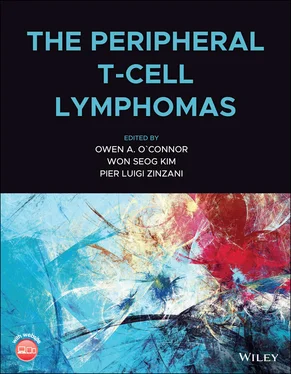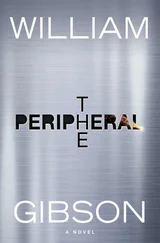47 47 Phillips, A.A., Shapira, I., Willim, R.D. et al. (2010). A critical analysis of prognostic factors in North American patients with human T‐cell lymphotropic virus type‐1‐associated adult T‐cell leukemia/lymphoma: a multicenter clinicopathologic experience and new prognostic score. Cancer 116: 3438–3446.
48 48 Laurini, J.A., Perry, A.M., Boilesen, E. et al. ((2012). Classification of non‐Hodgkin lymphoma in Central and South America: a review of 1028 cases. Blood 120: 4795–4801.
49 49 Chihara, D., Ito, H., Matsuda, T. et al. (2014). Differences in incidence and trends of haematological malignancies in Japan and the United States. Br J Haematol 164: 536–545.
50 50 Kawano, N., Yoshida, S., Kuriyama, T. et al. (2015). Clinical features and treatment outcomes of 81 patients with aggressive type adult T‐cellleukemia‐lymphoma report: single institution over a 7‐year period (2006‐2012). Intern Med 54 (12): 1489–1498.
51 51 Anh, P., Rachel, V., and Mary, J.L. (2016). T‐cell lymphoma epidemiology: the known and unknown. Curr Hematol Malig Rep 11: 492–503.
52 52 Iwanaga, M., Watanabe, T., and Yamaguchi, K. (2012). Adult T‐cell leukemia: review of epidemiological evidence. Front Microbiol 3: 322.
53 53 Koff, J.L., Chihara, D., Phan, A. et al. (2015). To each its own: linking the biology and epidemiology of NHL subtypes. Curr Hematol Malig Rep 10 (3): 244–255.
54 54 Yamamoto, J.F. and Goodman, M.T. (2008). Patterns of leukemia incidence in the United States by subtype and demographic characteristics, 1997–2002. Cancer Causes Control 19: 379–390.
55 55 Matutes, E. (2007). Adult T‐cell leukaemia/lymphoma. J Clin Pathol 60: 1373–1377.
56 56 Hanchard, B. (1996). Adult T‐cell leukemia/lymphoma in Jamaica: 1986–1995. J Acquir Immune Defic Syndr Hum Retrovirol 13 (Suppl 1)): S20–S25.
57 57 Yoshida, N. and Chihara, D. (2015). Incidence of adult T‐cell leukemia/ lymphoma in nonendemic areas. Curr Treat Options Oncol 16 (7): 1–8.
58 58 Jaffe, E.S., Chan, J.K., Su, I.J. et al. (1996). Report of the workshop on nasal and related extranodal angiocentric T/natural killer cell lymphomas: definitions, differential diagnosis, and epidemiology. Am J SurgPathol 20: 103–111.
59 59 Arber, D.A., Weiss, L.M., Albújar, P.F. et al. (1993). Nasal lymphomas in Peru. High incidence of T‐cell immunophenotype and Epstein–Barr virus infection. Am J Surg Pathol 17: 392–399.
60 60 Ai, W.Z., Chang, E.T., Fish, K. et al. (2012). Racial patterns of extranodal natural killer/T‐cell lymphoma, nasal type, in California: a population‐based study. Br J Haematol 156 (5): 626–632.
61 61 Au, W.Y., Weisenburger, D.D., Intragumtornchai, T. et al. (2009). Clinical differences between nasal and extranasal natural killer/T‐cell lymphoma: a study of 136 cases from the International Peripheral T‐Cell Lymphoma Project. Blood 113: 3931–3937.
62 62 Li, C.C., Tien, H.F., Tang, J.L. et al. (2004). Treatment outcome and pattern of failure in 77 patients with sinonasal natural killer/T‐cell or T‐cell lymphoma. Cancer 100: 366–375.
63 63 Matutes, E., Brito‐Babapulle, V., Swansbury, J. et al. (1991). Clinical and laboratory features of 78 cases of T‐prolymphocytic leukemia. Blood 78: 3269–3274.
64 64 Herling, M., Khoury, J.D., Washington, L.T. et al. (2004). A systematic approach to diagnosis of mature T‐cell leukemias reveals heterogeneity among WHO categories. Blood 104: 328–335.
65 65 Melo, J.V., Catovsky, D., and Galton, D.A. (1986). The relationship between chronic lymphocytic leukaemia and prolymphocytic leukaemia. I. Clinical and laboratory features of 300 patients and characterization of an intermediate group. Br J Haematol 63: 377–387.
66 66 Jain, P., Aoki, E., Keating, M. et al. (2017). Characteristics, outcomes, prognostic factors and treatment of patients with T‐cell prolymphocytic leukemia (T‐PLL). Ann Oncol 28: 1554–1559.
67 67 Brito‐Babapulle, V. and Catovsky, D. (1991). Inversions and tandem translocations involving chromosome 14q11 and 14q32 in T‐prolymphocytic leukemia and T‐cell leukemias in patients with ataxia telangiectasia. Cancer Genet Cytogenet 55: 1–9.
68 68 Taylor, A.M., Metcalfe, J.A., Thick, J., and Mak, Y.F. (1996). Leukemia and lymphoma in ataxia telangiectasia. Blood 87: 423–438.
69 69 Shah, M.V., Hook, C.C., Call, T.G., and Go, R.S. (2016). A population‐based study of large granular lymphocyte leukemia. Blood Cancer J 6 (8): e455.
70 70 Boeckx, N., Uyttebroeck, A., Langerak, A.W. et al. (2004). Clonal proliferation of T‐cell large granular lymphocytes. Pediatr Blood Cancer 42: 275–277.
71 71 Bareau, B., Rey, J., Hamidou, M. et al. (2010). Analysis of a French cohort of patients with large granular lymphocyte leukemia: a report on 229 cases. Haematologica 95: 1534–1541.
72 72 Goyal, T., Thakral, B., Wang, S.A. et al. (2018). T‐cell large granular lymphocytic leukemia and coexisting B‐cell lymphomas: a study from the bone marrow pathology group. Am J Clin Pathol 149: 164–171.
73 73 Dhodapkar, M.V., Li, C.Y., Lust, J.A. et al. (1994). Clinical spectrum of clonal proliferations of T‐large granular lymphocytes: a T‐cell clonopathy of undetermined significance? Blood 84: 1620–1627.
74 74 Jaffe, E.S. (2003). Pathology and Genetics of Tumours of Haematopoietic and Lymphoid Tissues. Lyon: International Agency for Research on Cancer Press.
75 75 Toro, J.R., Liewehr, D.J., Pabby, N. et al. (2003). Gamma‐delta T‐cell phenotypeis associated with significantly decreased survival in cutaneous T‐cell lymphoma. Blood 101 (9): 3407–3412.
76 76 Tripodo, C., Iannitto, E., Florena, A.M. et al. (2009). Gamma‐delta T‐cell lymphomas. Nat Rev Clin Oncol 6 (12): 707–717.
77 77 de Baaij, L.R., Berkhof, J., van de Water, J.M.W. et al. (2015). A new and validated clinical prognostic model (EPI) for enteropathy‐associated T‐cell lymphoma. Clin Cancer Res 21 (13): 3013–3019.
78 78 Tse, E., Gill, H., Loong, F. et al. (2012). Type II enteropathy‐associated T‐cell lymphoma: a multicenter analysis from the Asia lymphoma study group. Am J Hematol 87 (7): 663–668.
79 79 Yabe, M., Miranda, R.N., and Medeiros, L.J. (2018). Hepatosplenic T‐cell lymphoma: a review of clinicopathologic features, pathogenesis, and prognostic factors. Hum Pathol 74: 5–16.
80 80 Belhadj, K., Reyes, F., Farcet, J.P. et al. (2003). Hepatosplenic gammadelta T‐cell lymphoma is a rare clinicopathologic entity with poor outcome: report on a series of 21 patients. Blood 102 (13): 4261–4269.
81 81 Falchook, G.S., Vega, F., Dang, N.H. et al. (2009). Hepatosplenic gamma‐delta T‐cell lymphoma: clinicopathological features and treatment. Ann Oncol 20: 1080–1085.
82 82 Ross, C.W., Schnitzer, B., Sheldon, S. et al. (1994). Gamma/delta T‐cell posttransplantation lymphoproliferative disorder primarily in the spleen. Am J Clin Pathol 102: 310–315.
83 83 Burg, G. (2015). Systemic involvement in mycosis fungoides. Clin Dermatol 33 (5): 563–571.
84 84 Willemze, R. (2006). Primary cutaneous B‐cell lymphoma: classification and treatment. Curr Opin Oncol 18 (5): 425–431.
85 85 Scarisbrick, J.J., Kim, Y.H., Whittaker, S.J. et al. (2014). Prognostic factors, prognostic indices and staging in mycosis fungoides and Sézary syndrome: where are we now? Br J Dermatol 170 (6): 1226–1236.
86 86 Tan, E.S., Tang, M.B., and Tan, S.H. (2006). Retrospective 5‐year review of 131 patients with mycosis fungoides and Sézary syndrome seen at the National Skin Centre, Singapore. Australas J Dermatol 47 (4): 248–252.
87 87 Morales Suãrez‐Varela, M.M., Olsen, J., Kaerlev, L. et al. (2001). Are alcohol intake and smoking associated with mycosis fungoides? A European multicentre case‐control study. Eur J Cancer 37 (3): 392–397.
Читать дальше












